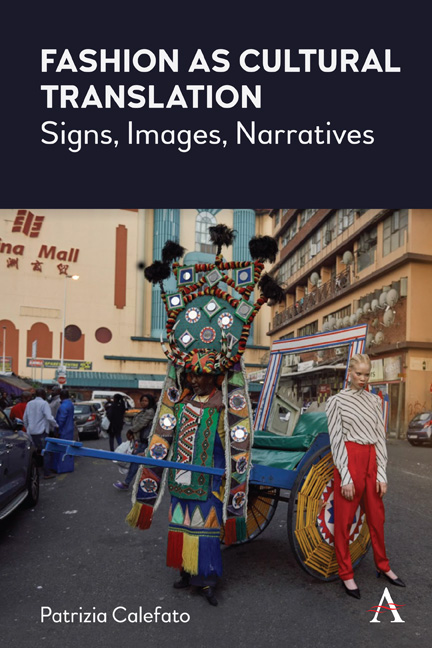Book contents
- Frontmatter
- Contents
- Introduction: Fashion as Cultural Translation in the Hyperconnected World
- Supplement to the Introduction: Fashion, the Hyperconnected World and Coronavirus
- 1 Time
- 2 Spaces
- 3 Fashion as Cultural Tradition: Italian Style
- 4 Fashion as Cultural Translation
- 5 Clothed Bodies
- 6 The Body as Text
- 7 Humans and Beyond
- 8 Fashion and the ‘Second Nature’
- 9 Fashion, Communication and Converging Media
- 10 Fashion Narratives in Visual Culture
- Conclusions: Fashion as an Idea about the Future
- References
- Index
Conclusions: Fashion as an Idea about the Future
Published online by Cambridge University Press: 18 February 2021
- Frontmatter
- Contents
- Introduction: Fashion as Cultural Translation in the Hyperconnected World
- Supplement to the Introduction: Fashion, the Hyperconnected World and Coronavirus
- 1 Time
- 2 Spaces
- 3 Fashion as Cultural Tradition: Italian Style
- 4 Fashion as Cultural Translation
- 5 Clothed Bodies
- 6 The Body as Text
- 7 Humans and Beyond
- 8 Fashion and the ‘Second Nature’
- 9 Fashion, Communication and Converging Media
- 10 Fashion Narratives in Visual Culture
- Conclusions: Fashion as an Idea about the Future
- References
- Index
Summary
In the book The End of Fashion (Geczy and Karaminas 2019), which followed the international transdisciplinary conference and exhibition of the same name held at Massey University in Wellington in 2016, the editors were inspired in choosing the title by an idea presented at the beginning of 2015 by the trend forecaster Lidewij Edelkoort in her Anti-Fashion Manifesto. The answer to the book's provocative question, ‘Is fashion over?’, is certainly ‘No’. However, the question underlies the awareness that what has changed are the forms which have defined fashion as such since the last century.
In the previous pages, I too have tried to argue this negative answer. Fashion, like history, does not ‘end’. Instead, it actively continues to create new connotations for the meaning of history and the relationship between present and past. What has ended is an understanding of fashion as being merely ornamental, artificial and an accessory because its aesthetic dimension has turned into – or will soon necessarily have to become – an ethical issue. What has ended is the idea of fashion as an excuse to exploit materials, people and goods for profit. What has ended is the misconception that the progress of technologies, materials and forms leads necessarily to the notion of beauty and goodness for the collective. As Benjamin used to say, it is fashion which shows us how illusory the idea of progress as linear and oriented towards the evolution of humanity is. In its ethical and critical conceptions, today's fashion shares global concerns towards the sustainability of our productive and communicative behaviours and consumption modalities. As the second-most polluting sector in the world, after oil, fashion knows that if it wants to have a future, it will have to think about the future. It is technology, understood as communicative technologies (such as blog and social networks as mediums for the re-intermediation and re-humanisation of communication) and as the development of new materials (such as fabrics, prosthetics and nanotechnologies) which demand fashion to establish a growing relationship with our senses. In doing so, fashion becomes a way to feel well about our bodies and extend this condition to the entire human genre.
- Type
- Chapter
- Information
- Fashion as Cultural TranslationSigns, Images, Narratives, pp. 115 - 116Publisher: Anthem PressPrint publication year: 2021



